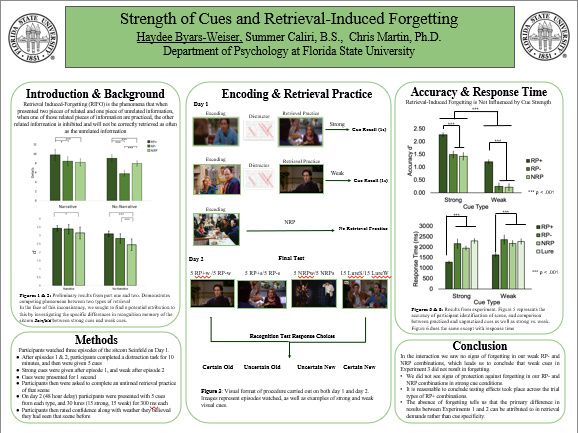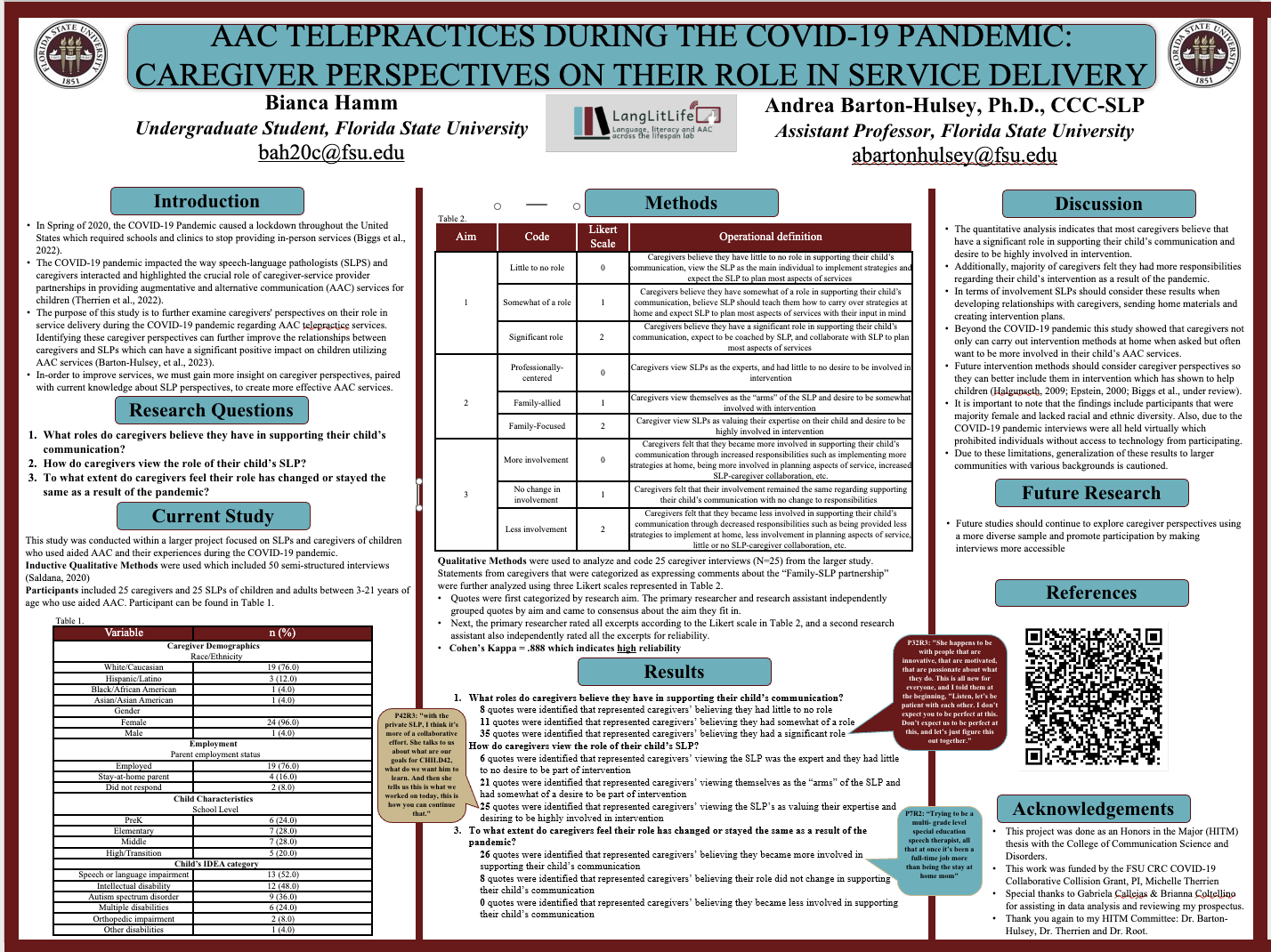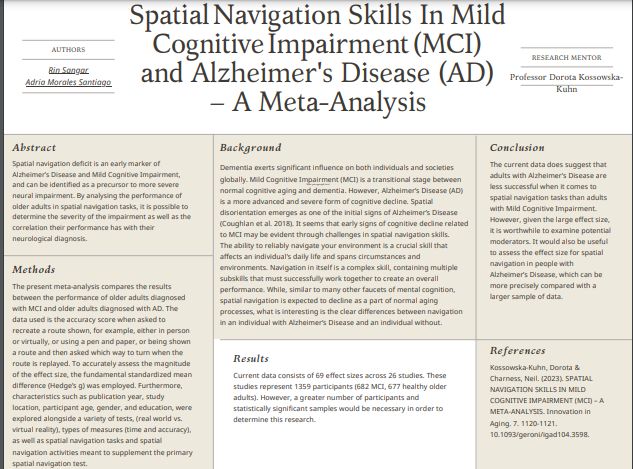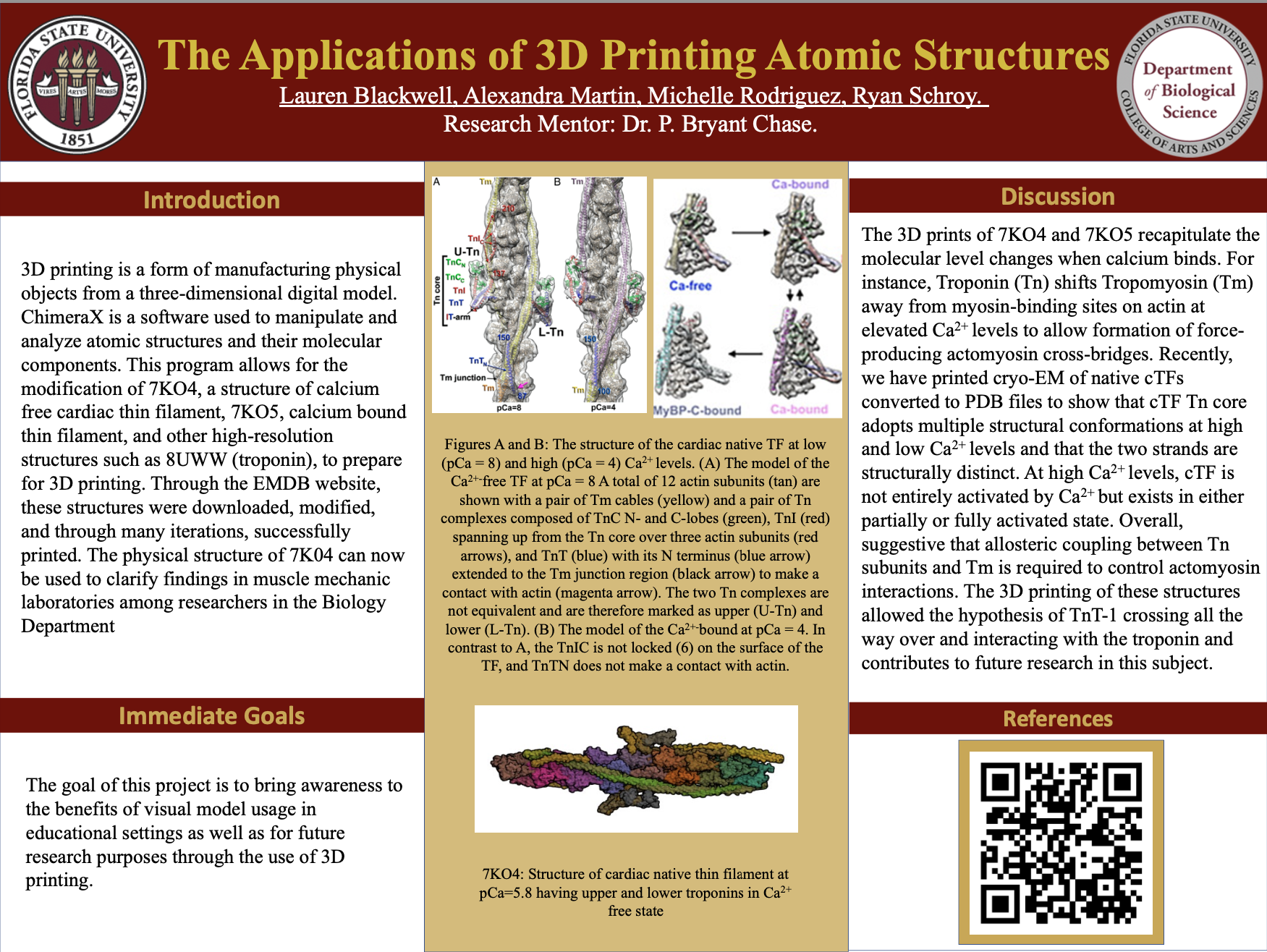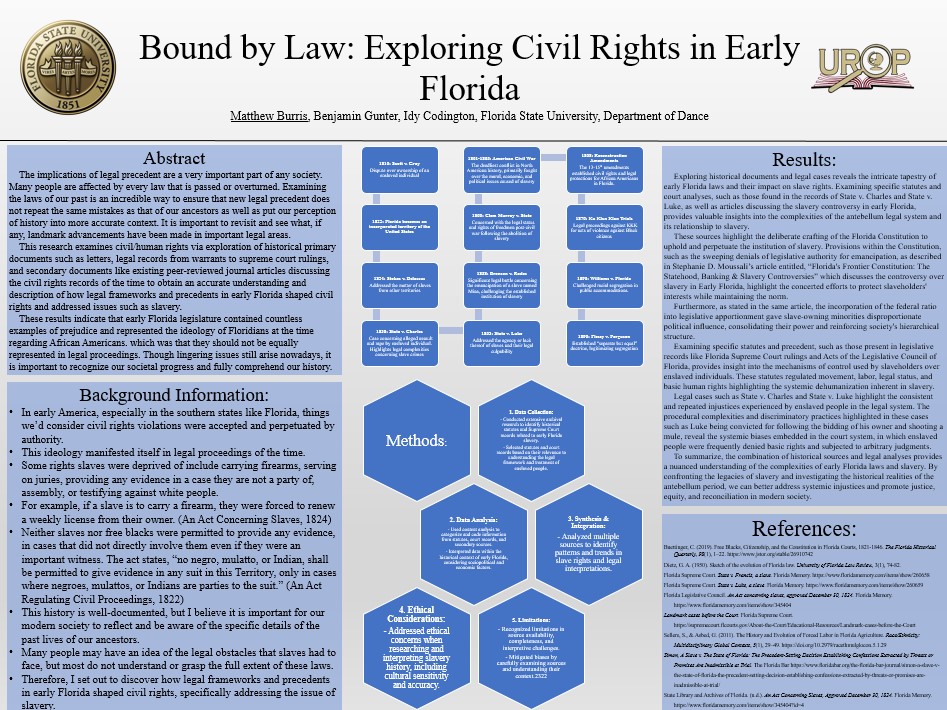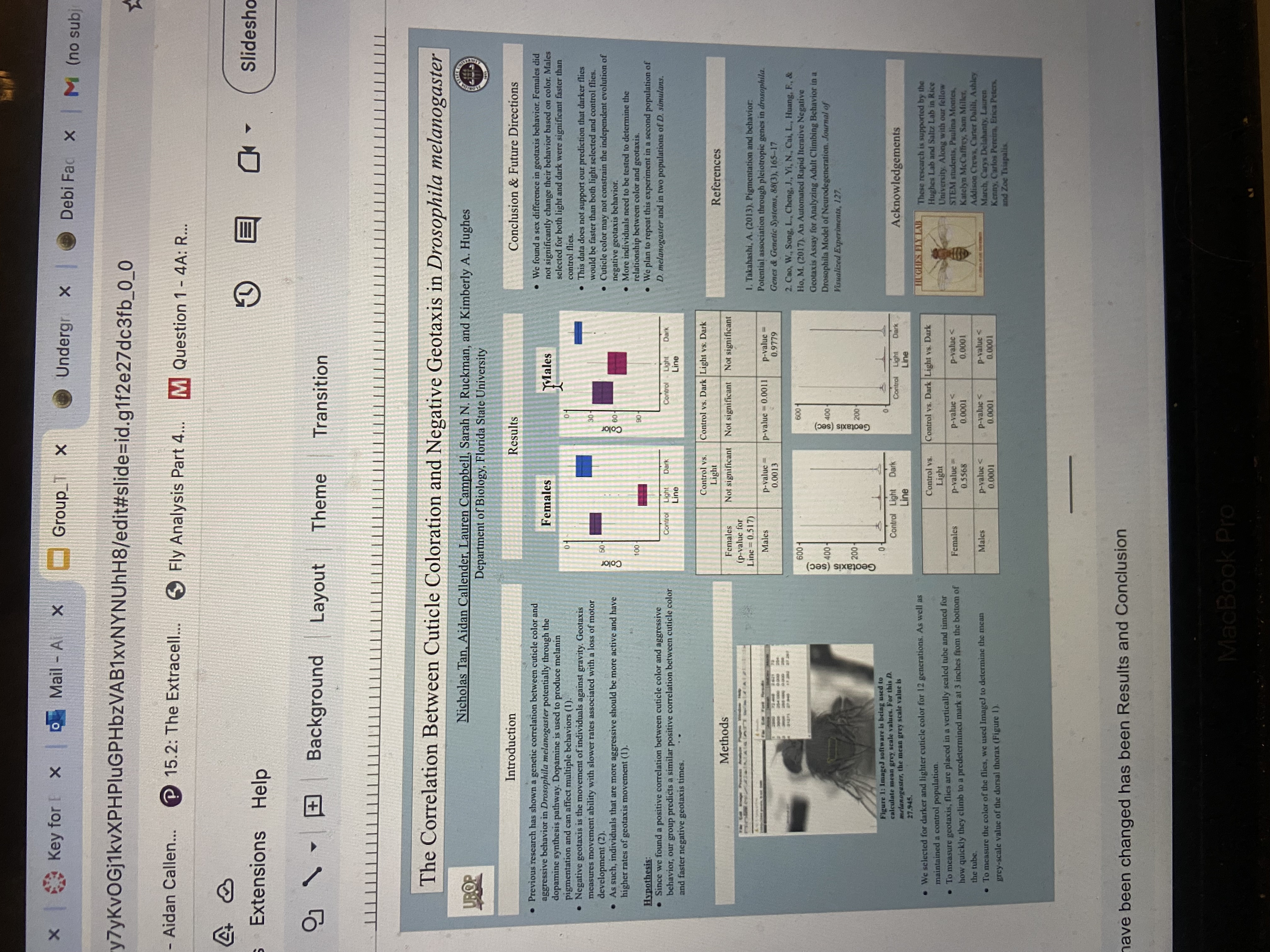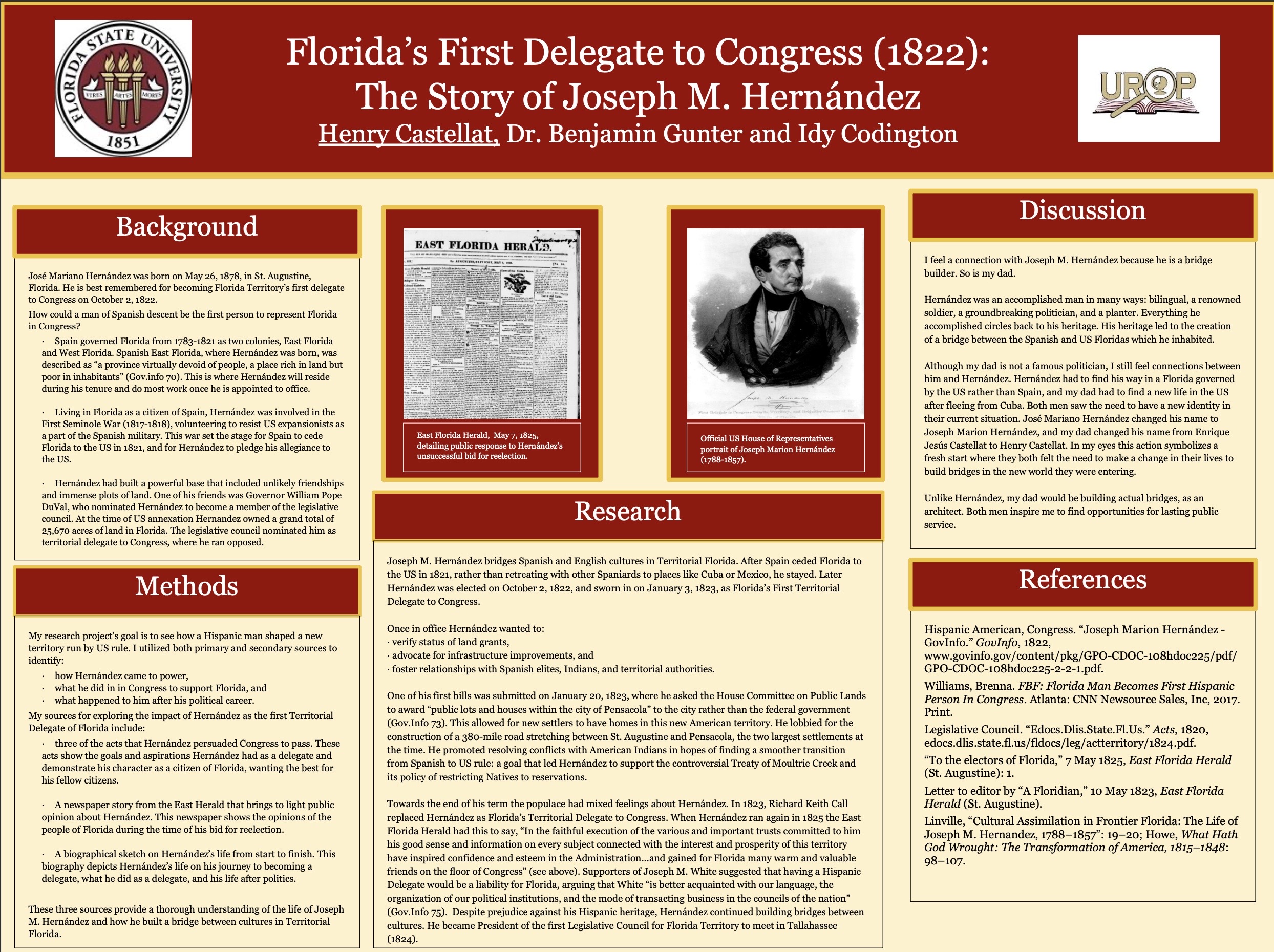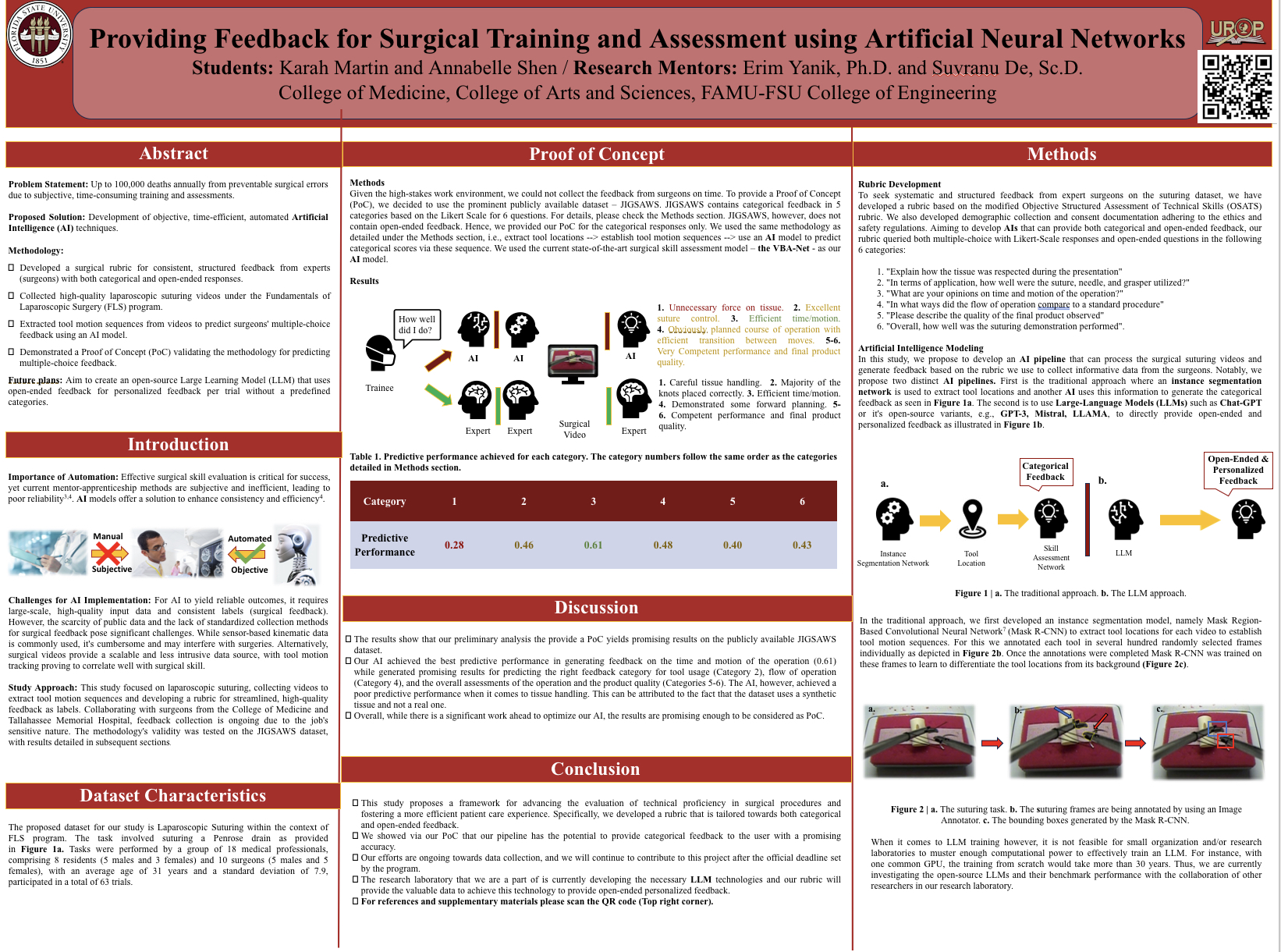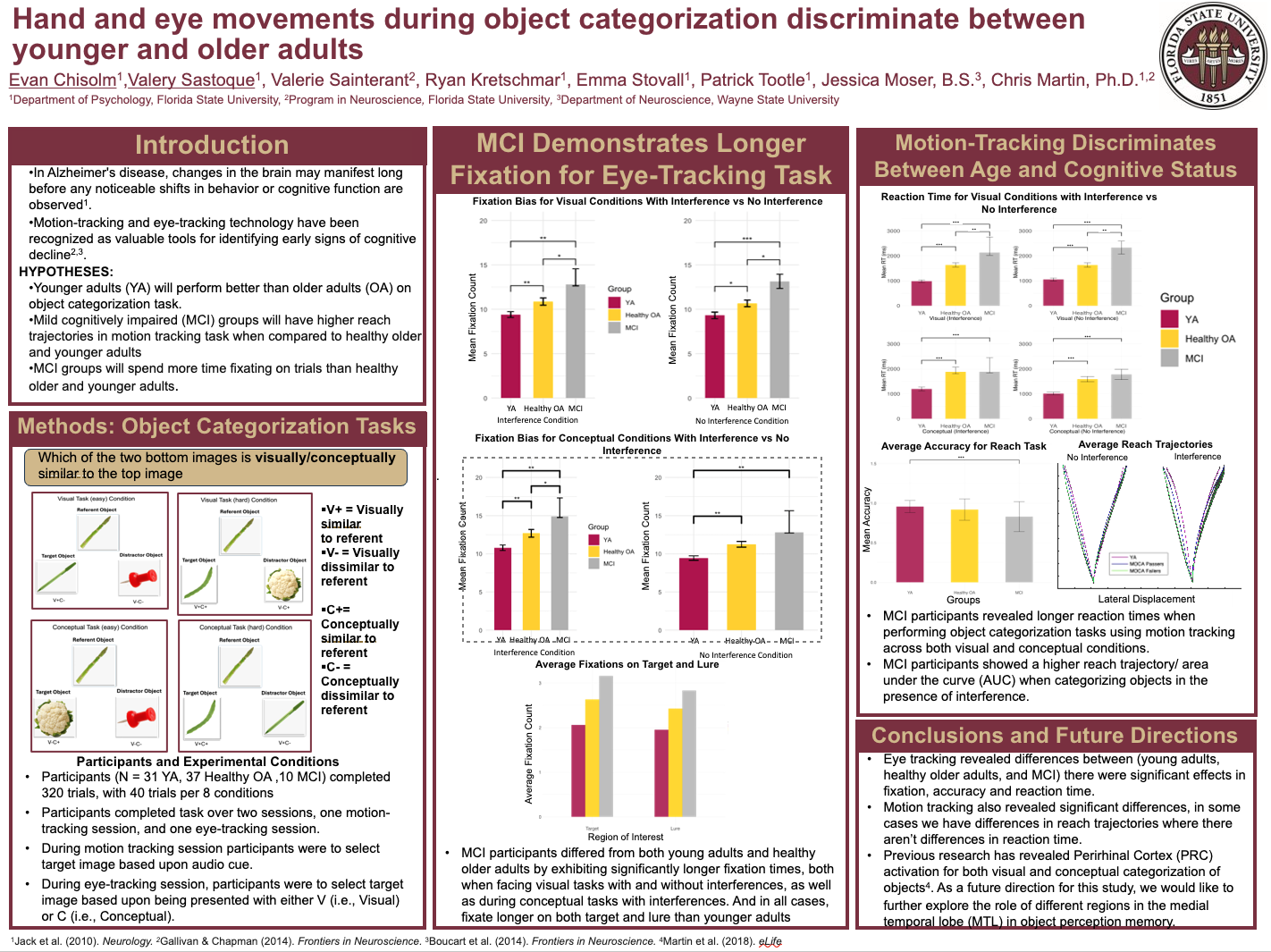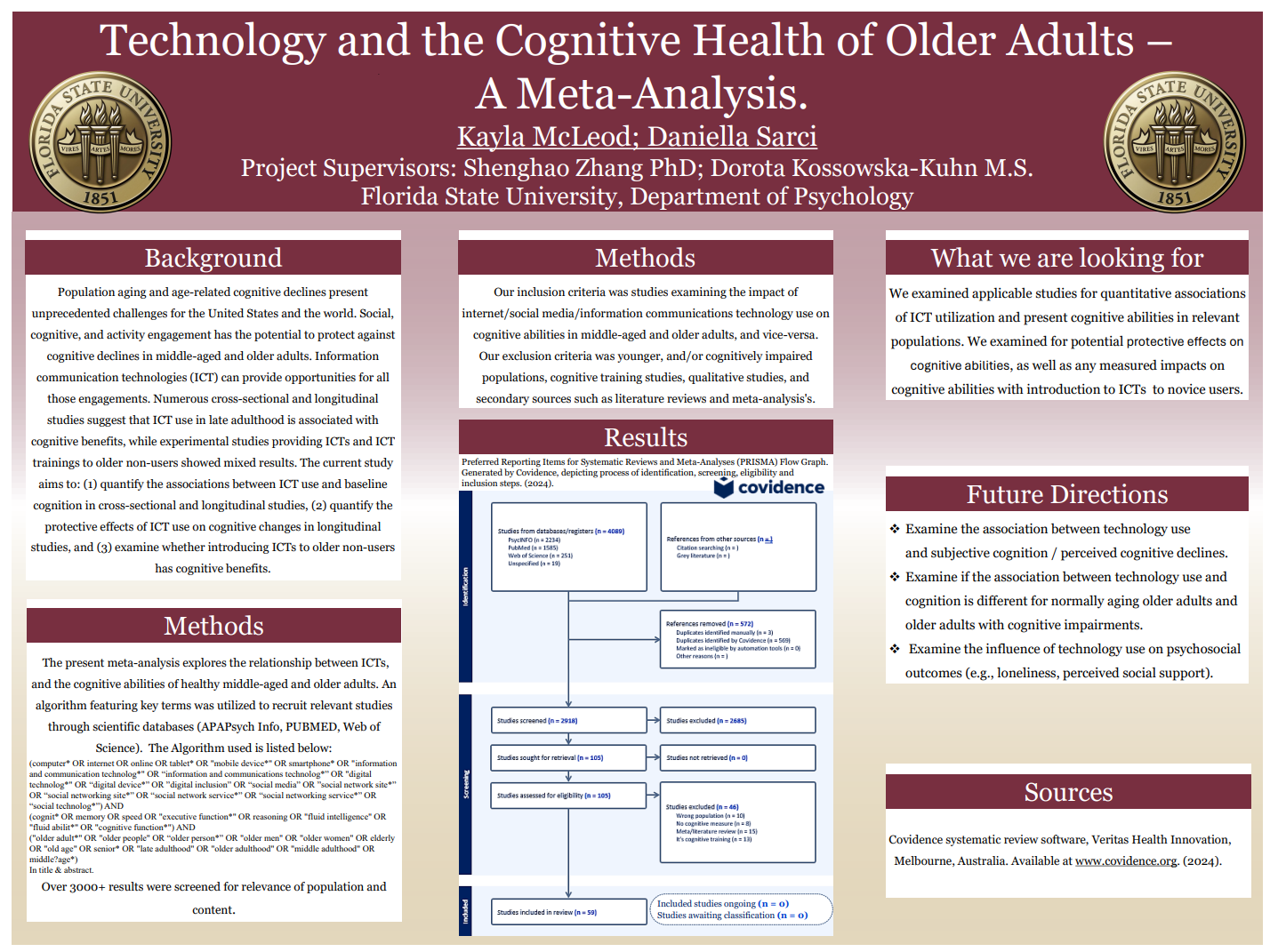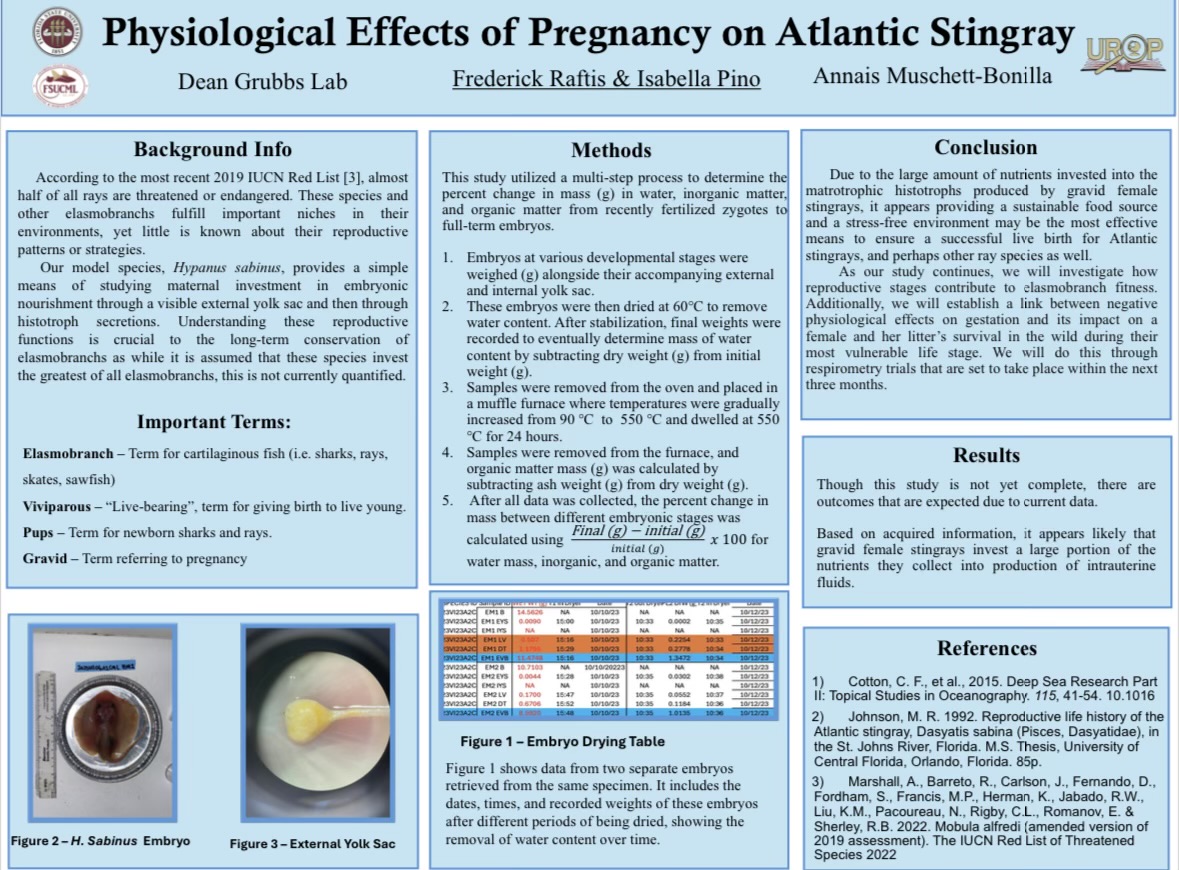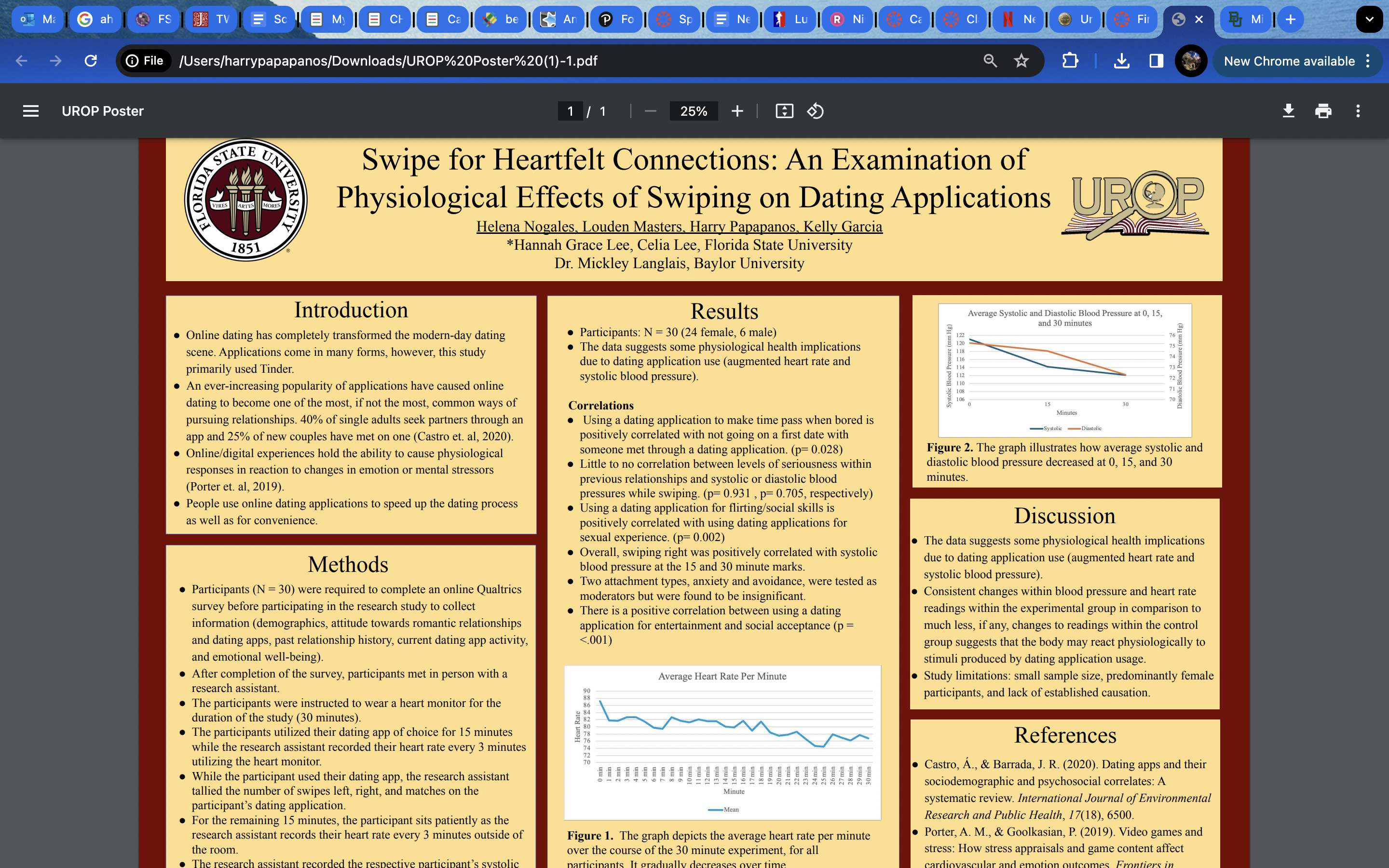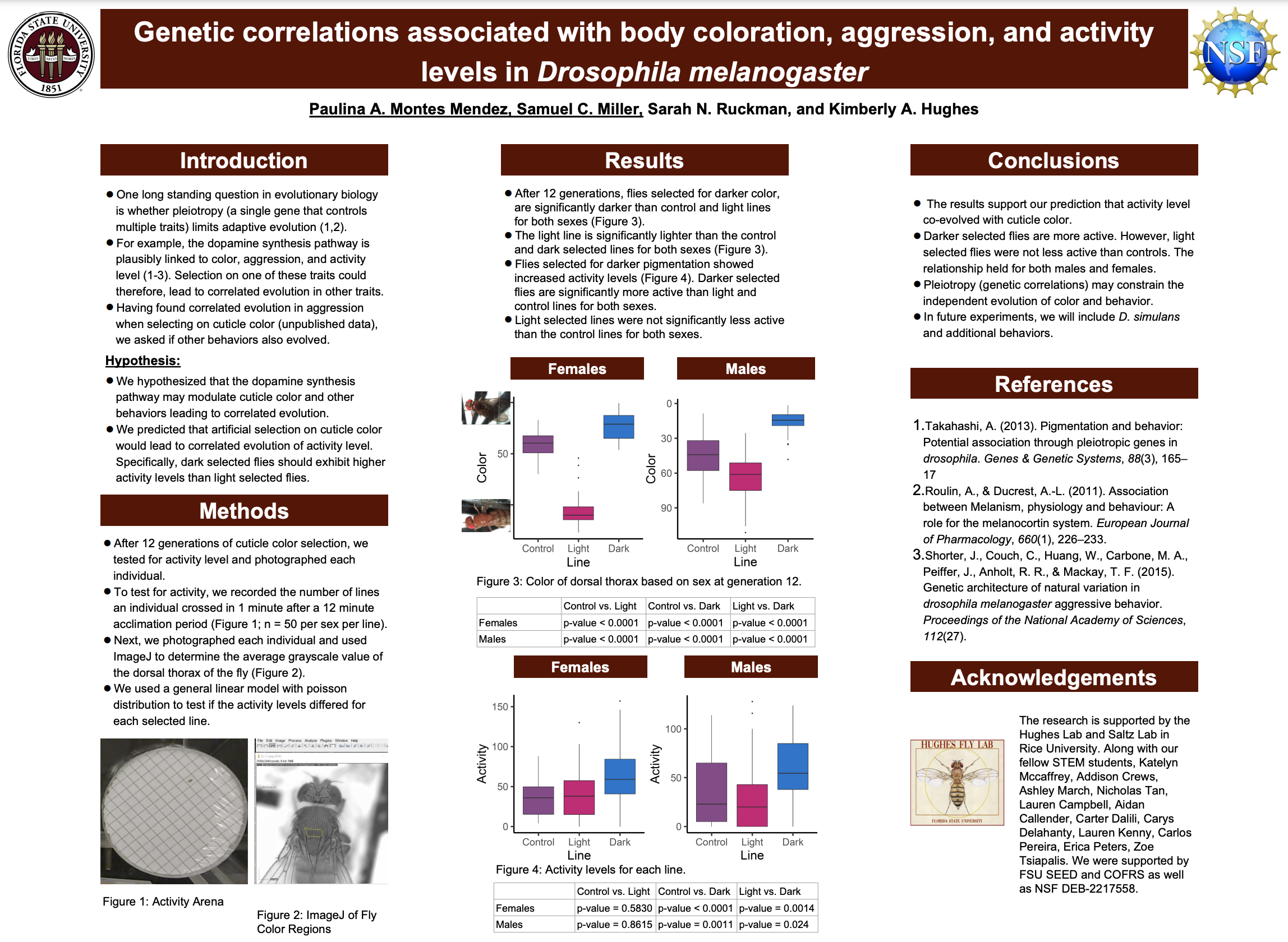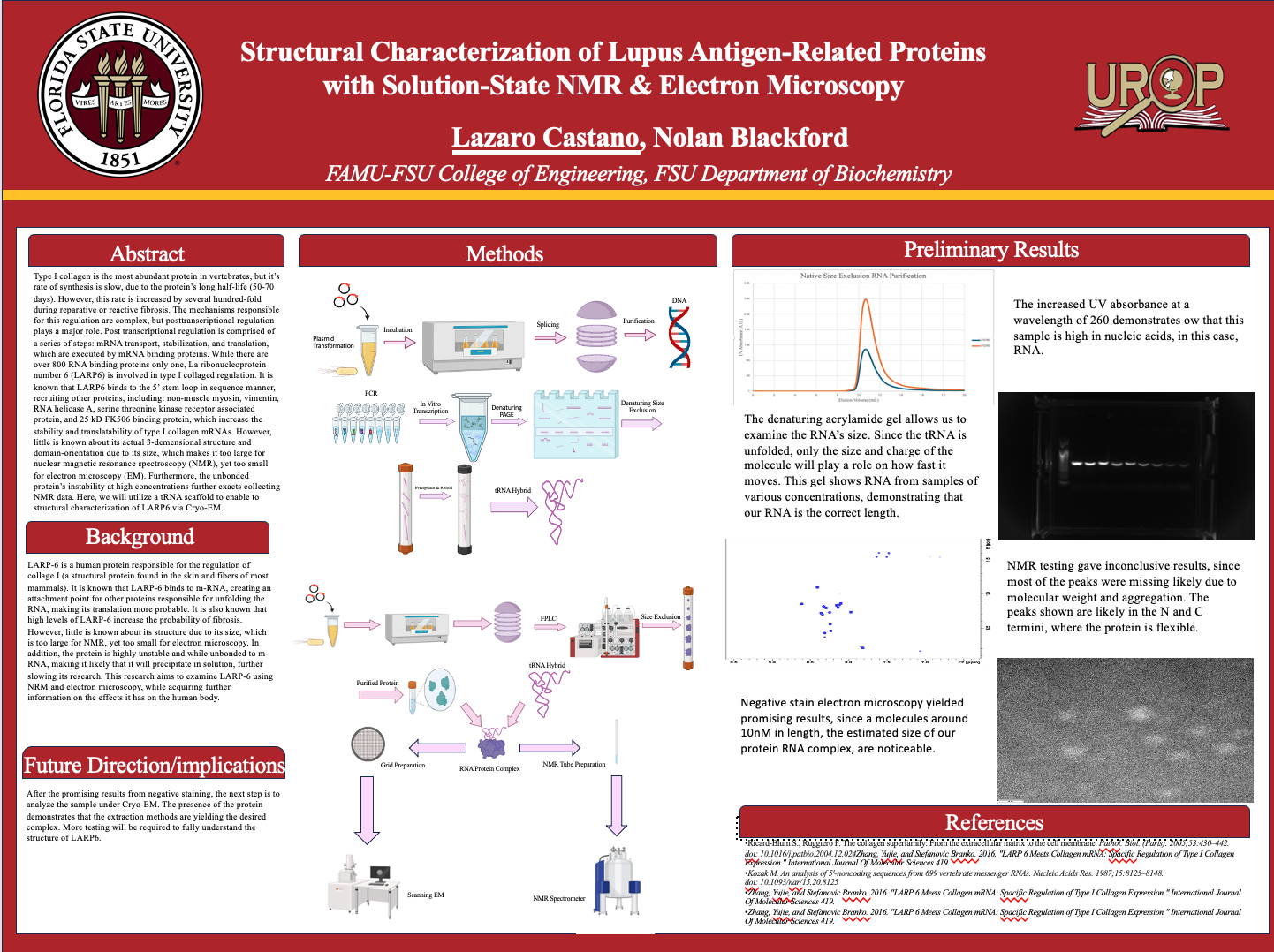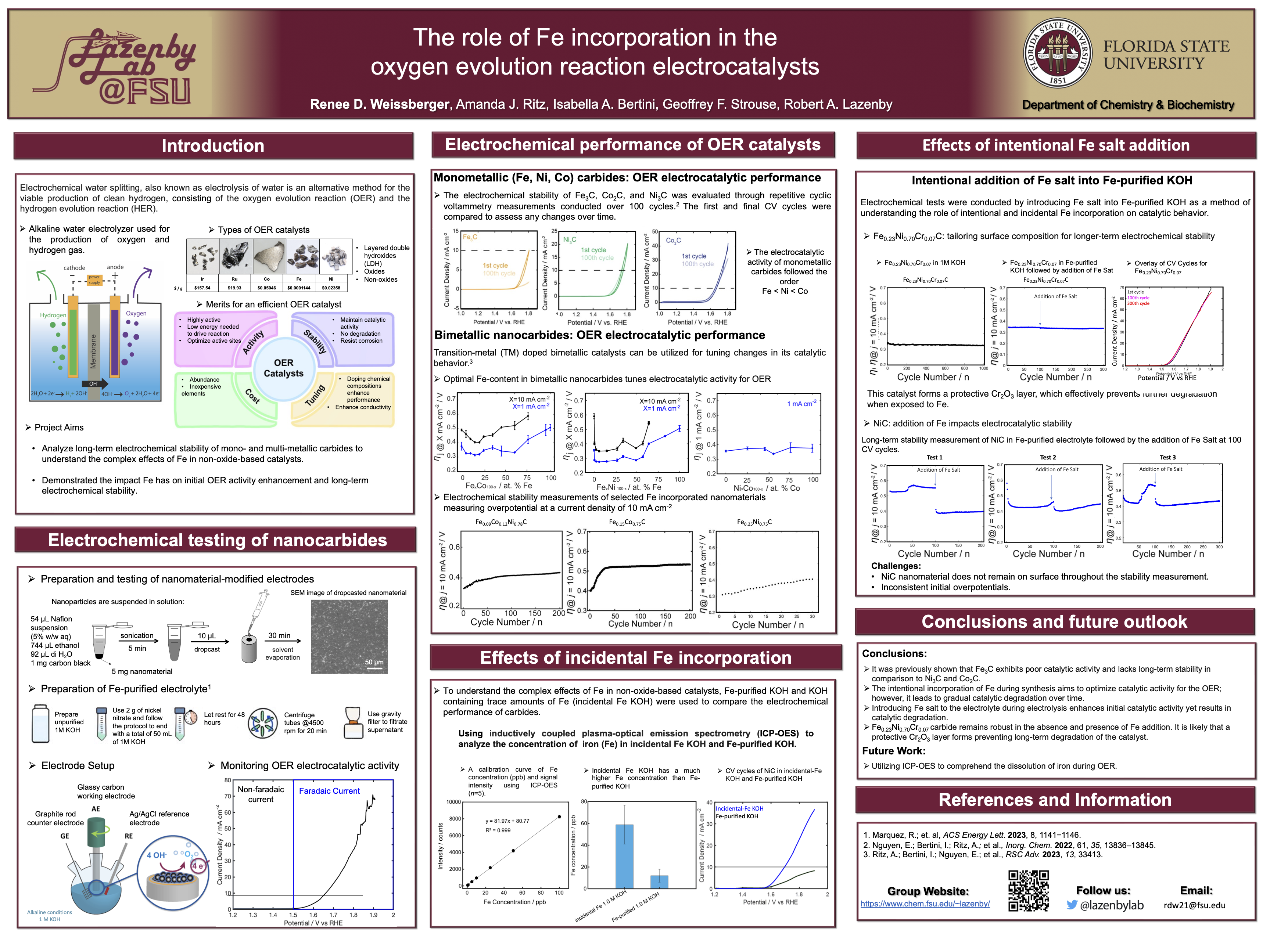Research Symposium
24th annual Undergraduate Research Symposium, April 3, 2024
Eliza Terziev Poster Session 5: 4:00 pm - 5:00 pm/149
BIO
I am a sophomore majoring in economics with minors in business, mathematics and politics, philosophy, & economics. I am originally from Champaign, Illinois. After college, I plan on pursuing a graduate degree in economics and I would love to live in Vermont some day!
The Role of Vacancies and Crime in Determining Home Prices
Authors: Eliza Terziev, Dr. Crystal TaylorStudent Major: Economics
Mentor: Dr. Crystal Taylor
Mentor's Department: Economics Mentor's College: College of Social Sciences and Public Policy Co-Presenters: Parker Ridaught
Abstract
Understanding homeowner vacancy and crime rates is critical to analyzing a community's growth potential and health. Home sale prices are clear indicators of a neighborhood's perception of quality and are influenced by standard home specifications and the characteristics of the surrounding neighborhood. Building on an abundant literature on the role vacancies and crime play in a community’s housing market, we ask the following: What role, if any, do homeowner vacancies and crime rates play in predicting a home’s sale price while controlling for other factors? We develop a hedonic price model of sales price that, in addition to typical housing characteristics, includes home vacancies and crime (property and violent) as explanatory variables. We use 2022 tax roll data from the Leon County Property Appraiser, 2021 ACS Data, and 2022 crime data from the Tallahassee Police Department. We also explore whether the effect of vacancies in an area depends on property and violent crime rates by introducing an interaction term to our model. Preliminary results suggest that home prices, on average, are lower in areas where vacancies are higher. Specifically, we observe a statistically significant relationship between the number of vacancies in a given home’s area and the home’s sale price. We also find that the effect of homeowner vacancies on sale price may depend on the level of violent and property crime in an area, although the direction of the effect is different between the two types of crime.
Keywords: Home Prices, Vacancy, Crime
24th annual Undergraduate Research Symposium, April 3, 2024
Carlos Pereira Poster Session 3: 1:30 pm - 2:30 pm/33

BIO
I am a senior in the athletic training major program. I am planning on applying to medical school in this next cycle. In my gap year I will be working as a medical assistant in Tampa, Fl.
Melanin and Behavior: Exploring Aggressiveness in Drosophila
Authors: Carlos Pereira, Sarah RuckmanStudent Major: Athletic Training
Mentor: Sarah Ruckman
Mentor's Department: Biological Science Mentor's College: Arts and Sciences Co-Presenters: Lauren Kenny
Abstract
One long standing question in evolutionary biology is whether single genes that control multiple traits (pleiotropy) results in limitations on adaptive evolution. If it does, then our ability to predict adaptation (e.g., in the face of changing environments) is compromised. We are using a much-discussed correlation between body coloration and aggressive behavior as a system to address this question. In Drosophila, this correlation is possibly attributed to dopamine being a precursor to melanin production. Higher melanin production would then result in less free dopamine, possibly resulting in more aggressive behaviors. To test the prediction that darker individuals were more aggressive, we selected for darker and lighter flies (D. simulans) and periodically test for aggressive behavior. Every 5 generations, we tested for aggression and photographed each individual. We used ImageJ to measure the color of the thorax of the fly. We found that the darker flies are more aggressive, suggesting a pleiotropic effect. Our results suggest that dark-selected flies evolved to be more aggressive. The next step in this study is to identify candidate genes underlying the correlation and test for pleiotropic effects using transgenic approaches.
Keywords: Drosophila Simulans
24th annual Undergraduate Research Symposium, April 3, 2024
Ryan Schroy Poster Session 2: 10:45 am - 11:45 am/432

BIO
I'm a senior from Fort Lauderdale who is passionate about my research. I am graduating this semester and taking a gap year before going to med school
The Applications of 3D Printing Atomic Structures
Authors: Ryan Schroy, P. Bryant ChaseStudent Major: biology
Mentor: P. Bryant Chase
Mentor's Department: Biology Mentor's College: College of Arts and Sciences Co-Presenters:
Abstract
3D printing is a form of manufacturing physical object from a three-dimensional digital model. ChimeraX is a software used manipulate and analyze atomic structures and their molecular components. With using ChimeraX and 3D printing, it is hoped to bring awareness to the benefits of visual model usage in educational settings as well as for future research purposes. ChimeraX was used to modify 7KO4, a structure of cardiac native thin filament, and other high-resolution structures such as 8UWW, to prepare for 3D printing. Blah blah Laurens steps. For the purpose of building a structure that can be separated and differentiated, ChimeraX will be used to color the different components of a muscle cell (actin, tropomyosin, and troponin). These components can then be magnetized with the aim of reassembly to understand how their processes work together. When 7KO4 was printed, it was used as a model to clarify findings in muscle mechanic laboratories among researchers in the Biology Department. This project is only the beginning for the implementation of 3D models in classroom environments and research presentations to demonstrate the importance of a cellular structure that is normally understood in its photographed two-dimensional state. Outside of the educational sphere, 3D models can be utilized in continued research. Their physical structures can aid in the identification of missing components or contribute towards higher understandings of the molecular structures as they can be modified and added to as new research develops and ideas are discovered.
Keywords: 7KO4, 7KO5, Ca2+
24th annual Undergraduate Research Symposium, April 3, 2024
Haydee Byars-Weiser Poster Session 4: 2:45 pm - 3:45 pm /106
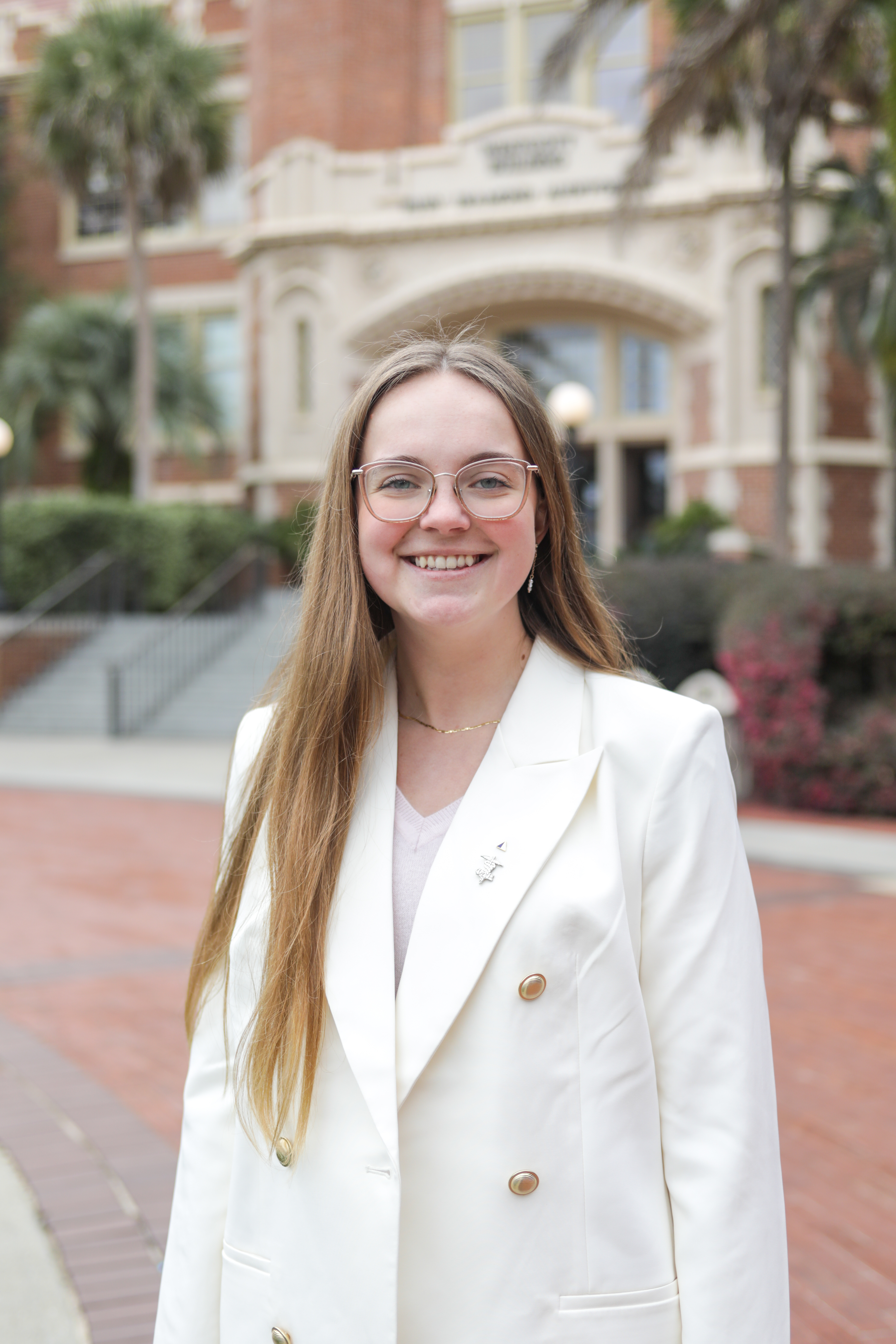
BIO
Hi! My name is Haydee, I am a behavioral neuroscience major, and a premed student, graduating this spring. I have been in the Martin Memory Lab as a research assistant for almost two years. My research interests include genetic disorders, and their influence on behavior in pediatric patients, particularly Autism Spectrum Disorder. I plan to pursue a MD/PhD program after taking a gap year following my graduation.
Strength of Cues and Retrieval-Induced Forgetting
Authors: Haydee Byars-Weiser, Chris MartinStudent Major: Behavioral Neuroscience
Mentor: Chris Martin
Mentor's Department: Department of Psychology Mentor's College: College of Arts and Sciences Co-Presenters:
Abstract
Studies of human memory have shown that retrieval practice increases the likelihood of later recalling practiced information. This has been called the test effect. However, retrieval practice also affects the likelihood of later recalling unpracticed information. In some contexts, it can cause forgetting (retrieval-induced forgetting; RIFO), which is thought to be driven by inhibition of unpracticed items during retrieval practice. We have previously shown that the presence of narrative structure in naturalistic stimuli protects against RIFO on recall tasks with weak retrieval cues but not on recognition tasks with strong retrieval cues. Here, we investigated this inconsistency, asking whether it reflected differences in the strength of the cues (strong vs. weak) or differences in retrieval demands (recall vs. recognition). To this end, we manipulated cue strength and held retrieval demands constant in a classic RIFO paradigm, i.e., (i) encode naturalistic stimuli without a narrative, (ii) complete retrieval practice for a subset of the previously encoded information, and (iii) complete a recognition memory test with either strong or weak cues. Strong cues were unambiguous still frames from the previously encoded stimuli, whereas weak cues were ambiguous still frames. If the differences in our previous studies can be attributed to cue strength, then strong and weak cues should differentially affect performance for unpracticed information. If, however, the differences reflected retrieval demands, performance should be comparable across strong and weak cues. Our results supported the latter interpretation as unpracticed information was recalled with equal probability following retrieval practice with strong and weak cues.
Keywords: memory psychology behavior Seinfeld
24th annual Undergraduate Research Symposium, April 3, 2024
Bianca Hamm Poster Session 1: 9:30 am - 10:30 am /235

BIO
Bianca is a senior at Florida State University pursuing a Bachelor of Science in Communication Science and Disorders with a minor in Psychology from Jacksonville, Florida. She plans to attend graduate school at Auburn University to obtain a Master of Science in Speech Language Pathology with a research focus on augmentative and alternative communication, caregiver perspectives, early intervention and diversity, equity, and inclusion.
AAC TELEPRACTICE SERVICES DURING THE COVID-19 PANDEMIC: CAREGIVER PERSPECTIVES ON THEIR ROLE IN SERVICE DELIVERY
Authors: Bianca Hamm, Dr. Andrea Barton-HulseyStudent Major: Communication Science and Disorders
Mentor: Dr. Andrea Barton-Hulsey
Mentor's Department: School of Communication Science and Disorders Mentor's College: College of Communication and Information Co-Presenters:
Abstract
One of the most influential environments where young children develop is in their homes with their families or caregivers. Since children spend a significant amount of time with their family environment it is essential to understand this dynamic when providing early childhood education and intervention programs such as at home telepractice (Halgunseth, 2009; Epstein, 2001). While there are several studies about teletherapy feasibility, accessibility, and effectiveness and the SLP perspective, not many have focused on the perspectives of caregivers involved in AAC services (Coltellino, 2022; Barton-Hulsey et al., in print; Lincoln et al., 2014). Therefore the purpose of this study is to identify caregivers' opinions on service delivery, specific barriers they may be experiencing and what their beliefs are regarding their role in supporting AAC service delivery. The proposed study was conducted within a larger project focused on SLPs and caregivers of children who used aided AAC and their experiences during the COVID-19 pandemic.This descriptive qualitative study (Sandelowski, 2000, 2010) involved fifty semi-structured interviews and content analysis (Patton, 2015). The proposed study plans to analyze twenty five of the caregiver interviews that were coded as “caregiver beliefs” and use quantitative analysis to gain insight into caregiver perspectives. Consensus coding will be used to allow the results to be more reliable and valid. Although this study aims to give insight into the caregivers’ role in service delivery, there is still more to be known about caregiver perspectives, their beliefs and attitudes.
Keywords: Communication, AAC, Speech-pathology
24th annual Undergraduate Research Symposium, April 3, 2024
Emily Caleap Poster Session 2: 10:45 am - 11:45 am/442

BIO
Hello, my name is Emily Caleap and I am from Pensacola, Florida. I am currently a freshman here at FSU working towards my nursing degree. I found this topic particularly interesting as it discusses the positive impact of COVID-19, rather than the negative one. I am honored to be a part of this research and I hope you all find it as interesting as I do.
Impact of COVID-19 on Caregiver’s of Children with Special Health Needs
Authors: Emily Caleap, Mandy BamberStudent Major: NFA-Nursing
Mentor: Mandy Bamber
Mentor's Department: Nursing Mentor's College: College of Nursing Co-Presenters: Kara Sloper
Abstract
Caregivers of children with special health needs experience an abundance of stress throughout their everyday lives. Having an individual who is completely dependent on their caregiver can be greatly taxing due to the complexity and extent of care. The goal of this study was to determine the effects of COVID-19 on caregivers of children with special health needs. Twenty five caregivers were interviewed and asked about their daily routines, selfcare habits, and experiences with COVID-19. The interviews were then coded via thematic analysis to determine common themes among the participants. Although the discussion of COVID-19 typically focuses on negative and adverse effects, the results indicated that many caregivers experienced unexpected benefits and support during the pandemic. Many participants agreed that access to resources such as grocery delivery, tele-health appointments, and working remotely made their role as a caregiver less stressful. Less time was spent on route to doctor appointments, therapies, and education. Many caregivers also agreed that the social isolation experienced during the pandemic was no different from their normal daily precautions, resulting in less emotional and social impact. By understanding the impacts of COVID-19 on caregivers of children with special health needs, individuals can work to improve health outcomes and provide support to this vulnerable population.
Keywords: Caregivers of Children with Special Needs
24th annual Undergraduate Research Symposium, April 3, 2024
Adria Morales Santiago Poster Session 3: 1:30 pm - 2:30 pm/51

BIO
My name is Adria Morales Santiago, and I am a freshman majoring in Biological Sciences. I am from Cuba, but I am currently residing in Naples, Florida. After I complete my undergraduate studies, I plan to pursue medical school with the goal of becoming a surgical oncologist. I want to become more involved in cancer research with a focus on the molecular and cellular processes. I am also interested in psychology, specifically how Alzheimer's Disease affects the lives of the older population. In my free time I enjoy reading, volunteering, and learning new languages.
Spatial Navigation Skills In Mild Cognitive Impairment (MCI) and Alzheimer's Disease (AD) – A Meta-Analysis
Authors: Adria Morales Santiago, Dorota Kossowska-KuhnStudent Major: Biological Sciences
Mentor: Dorota Kossowska-Kuhn
Mentor's Department: Psychology Mentor's College: College of Arts and Sciences Co-Presenters: Rin Sangar
Abstract
Abstract:
Background: Spatial disorientation emerges as a prominent early indicator of Alzheimer's Disease (AD), as emphasized in the 2018 study by Coughlan et al. Difficulties in spatial navigation frequently manifest in individuals with Mild Cognitive Impairment (MCI), a syndrome with a high probability of progressing to dementia. A prior meta-analysis demonstrated a significant difference (p < 0.05) in navigation skills between healthy cognitively older adults and individuals with MCI, with a standardized mean difference (SMD) of 0.88.
Methods: The present meta-analysis compares the results between the performance of older adults diagnosed with MCI and older adults diagnosed with AD. To accurately assess the magnitude of the effect size, the standardized mean difference (Hedge’s g) will be employed.
Results: Following our literature search, we identified 16 studies that fulfilled our inclusion criteria. We are currently in the midst of extracting data from these studies.
Keywords: Spatial navigation, Alzheimer's Disease, Mild-Cognitive Disorder
24th annual Undergraduate Research Symposium, April 3, 2024
Michelle Rodriguez Poster Session 1: 9:30 am - 10:30 am /432

BIO
My name is Michelle Rodriguez and I am a junior majoring in Biology with a minor in Chemistry from Miami, Florida. In the future I plan to pursue a master's degree in anesthesia to become an anesthesiologist assistant.
The Applications of 3D Printing Atomic Structures
Authors: Michelle Rodriguez, Dr. ChaseStudent Major: Biological Sciences
Mentor: Dr. Chase
Mentor's Department: Biology Mentor's College: Arts and Sciences Co-Presenters: Alexandra Martin, Lauren Blackwell, Ryan Schroy
Abstract
3D printing is a form of manufacturing physical objects from a three-dimensional digital model. ChimeraX is a software used to manipulate and analyze atomic structures and their molecular components. ChimeraX was used to modify 7KO4, a structure of cardiac native thin filament, and other high-resolution structures such as 8UWW (troponin), to prepare for 3D printing. Through the EMDB website, these structures were downloaded, modified, and through trial and many stl files later successfully printed. For the purpose of building a structure that can be separated and differentiated, ChimeraX will be used to color the different components of a muscle cell (actin, tropomyosin, and troponin). These components can then be magnetized with the aim of reassembly to understand how their processes work together. When 7KO4 was printed, it was used as a model to clarify findings in muscle mechanic laboratories among researchers in the Biology Department. We hope to bring awareness to the benefits of visual model usage in educational settings as well as for future research purposes through the use of 3D printing and ChimeraX. This project demonstrates the importance of a physical cellular structure that is normally understood in its photographed two-dimensional state. Outside of the educational sphere, 3D models can aid in the identification of missing components or contribute towards a higher understanding of molecular structures. These prints can be modified and added to as new research develops and ideas are discovered.
Keywords: 3D Printing, Cardiac Muscle, Actin, Troponin
24th annual Undergraduate Research Symposium, April 3, 2024
Matthew Burris Poster Session 1: 9:30 am - 10:30 am /325

BIO
I am a psychology major interested in history and research.
Bound by Law: Exploring Civil Rights in Early Florida
Authors: Matthew Burris, Benjamin GunterStudent Major: Psychology
Mentor: Benjamin Gunter
Mentor's Department: Dance Mentor's College: Fine Arts Co-Presenters: N/A
Abstract
The implications of legal precedent are a very important part of any society. Many people are affected by every law that is passed or overturned. Examining the laws of our past is an incredible way to ensure that new legal precedent does not repeat the same mistakes as that of our ancestors as well as put our perception of history into more accurate context. It is important to revisit and see what, if any, landmark advancements have been made in important legal areas.
This research examines civil/human rights via exploration of historical primary documents such as letters, legal records from warrants to supreme court rulings, and secondary documents like existing peer-reviewed journal articles discussing the civil rights records of the time to obtain an accurate understanding and description of how legal frameworks and precedents in early Florida shaped civil rights and addressed issues such as slavery.
These results indicate that early Florida legislature contained countless examples of prejudice and represented the ideology of Floridians at the time regarding African Americans. which was that they should not be equally represented in legal proceedings. Though lingering issues still arise nowadays, it is important to recognize our societal progress and fully comprehend our history.
Keywords: Florida, History, Civil Rights
24th annual Undergraduate Research Symposium, April 3, 2024
Aidan Callender Poster Session 2: 10:45 am - 11:45 am/330

BIO
I am a junior at Florida State University and I am in my third year. I am planning on graduating with a bachelor's in biology and am planning on applying for PA schools once I graduate. I am currently participating in Dr. Hughes lab researching the genetic connections between coloration and behavior.
The Correlation Between Cuticle Coloration and Negative Geotaxis in Drosophila Melanogaster
Authors: Aidan Callender, Sarah RuckmanStudent Major: Biology
Mentor: Sarah Ruckman
Mentor's Department: Ecology and Evolution Mentor's College: Florida State University Co-Presenters: Nicholas Tan, Lauren Campbell
Abstract
One long standing question in evolutionary biology is whether single genes that control multiple traits (pleiotropy) results in limitations on adaptive evolution. If it does, then our ability to predict adaptation (e.g., in the face of changing environments) is compromised. We are using a much-discussed correlation between body coloration and aggressive behavior as a system to address this question. Having found the predicted genetic correlation between cuticle color and aggressive behavior in Drosophila melanogaster using artificial selection (unpublished data), we then asked if any other behaviors co-evolved under selection on cuticle color. For example, the dopamine synthesis pathway is plausibly related to color, aggression, and other behaviors, such as geotaxis level. Negative geotaxis is the movement of individuals against gravity. This is a measure for general activity and motor development. Efficiency of geotaxis has been used to measure movement ability, with a slower rate of geotaxis associated with a loss of motor development and neurodegeneration. We therefore measured geotaxis ability of flies (D. melanogaster) selected for darker and lighter cuticle color. To measure geotaxis, flies are placed in a vertically sealed tube and timed for how quickly they climb to a predetermined mark at 3 inches from the bottom of the tube. Results suggest that time to climb to the top of the tube is faster in the dark-selected lines, suggesting that genetic correlations do constrain the independent evolution of cuticle color and behavior.
Keywords: Negative Geotaxis, coloration
24th annual Undergraduate Research Symposium, April 3, 2024
Henry Castellat Poster Session 2: 10:45 am - 11:45 am/410
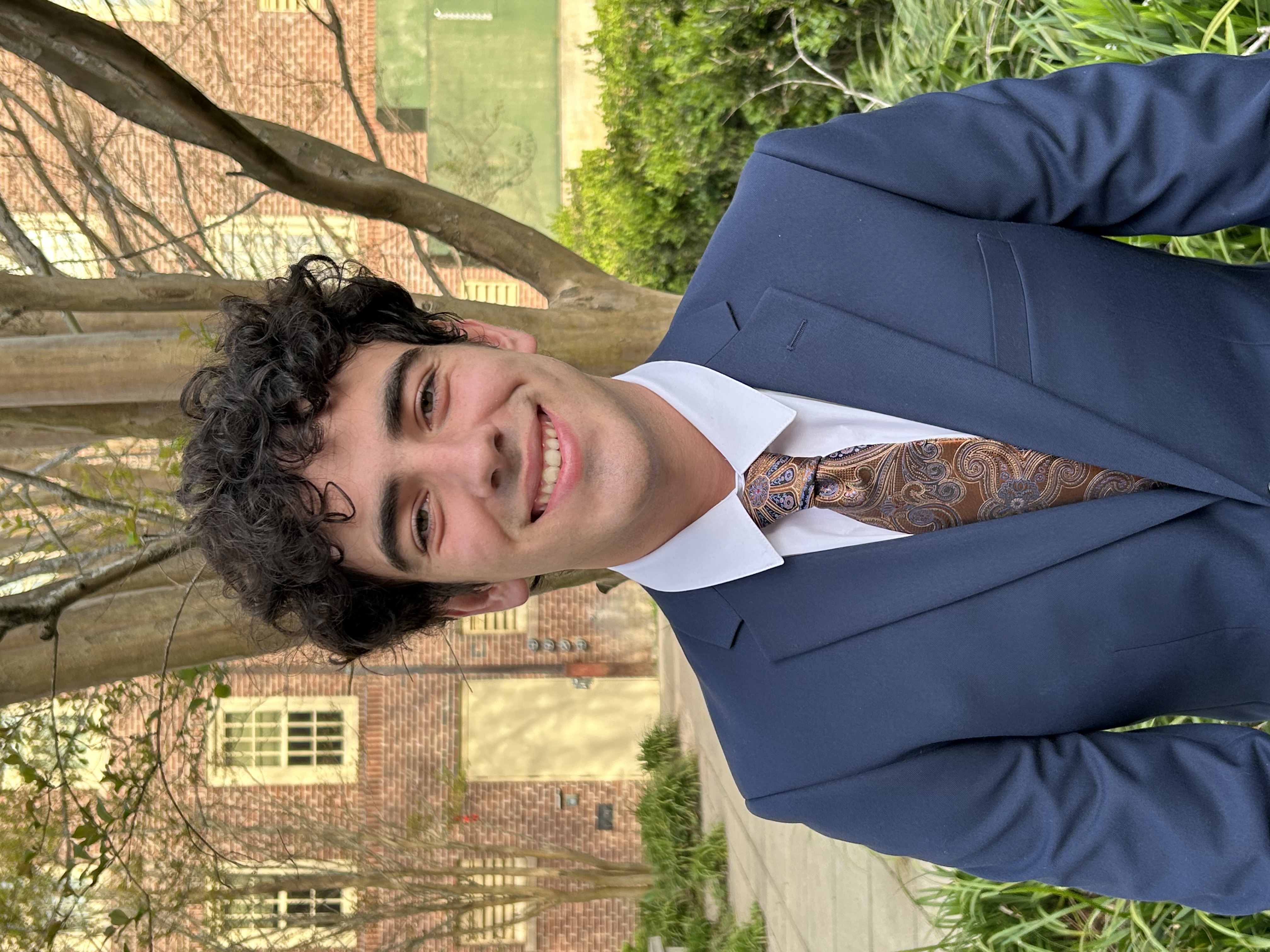
BIO
My name is Henry Castellat and I am from Miami, Florida. As a researcher my goals were to learn how to properly research a topic and put those skills into further use as I continue my academic career. My career goals are to get into the cyber security field and work alongside big names such as Google or Amazon.
Florida’s First Delegate to Congress (1822): The Story of Joseph M. Hernández
Authors: Henry Castellat, Benjamin GunterStudent Major: Cyber Criminology
Mentor: Benjamin Gunter
Mentor's Department: Benjamin Gunter Mentor's College: Florida State University Co-Presenters:
Abstract
Joseph Marion Hernández made a lasting impact on early Tallahassee through his pioneering role as the first Hispanic delegate to the U.S. Congress and his influential presence in the Florida Territory during the 19th century. As a prominent figure, Hernández played a crucial role in bridging cultural divides and fostering a sense of inclusion for the transition of Spanish Rule to US Rule. His political achievements opened doors for greater representation and participation of Hispanics in the political landscape of the region, helping to establish a foundation for their social and economic integration. Additionally, Hernández's contributions to the negotiation of land treaties with Native American tribes indirectly benefited Hispanic settlers, facilitating the growth and prosperity of the community. Through his leadership and advocacy, Joseph Marion Hernández left an indelible mark on early Tallahassee, contributing to not only the city but the whole state of Florida with his land grants, treaties, and incredible reputation.
Keywords: Marion, First Seminole War, East Florida Herald
24th annual Undergraduate Research Symposium, April 3, 2024
Annabelle Shen Poster Session 2: 10:45 am - 11:45 am/244

BIO
I am a freshman majoring in Chemistry at Florida State University. I have always been interested in discovering ways technology can improve our current healthcare systems. I hope to continue research in this area throughout college, and I aspire to be a physician in the future.
Providing Feedback for Surgical Training and Assessment Using Artificial Neural Networks
Authors: Annabelle Shen , Erim YanikStudent Major: Chemistry
Mentor: Erim Yanik
Mentor's Department: Engineering Mentor's College: FAMU-FSU College of Engineering Co-Presenters: Karah Martin
Abstract
Because current surgical residents are evaluated by attending physicians, this subjective, human nature can impact surgical outcomes, resulting in the loss of approximately 400,000 lives annually due to surgical errors. Through the use of artificial intelligence and computer vision, surgical tools can be classified and segmented, aiding in improving the objectivity and accuracy of real-time diagnoses. A Mask Region-based Convolutional Neural Networks (Mask RCNN will be used for object detection (classifying objects in images and videos) and instance segmentation (identifying different instances of the same object and separating the different objects through determining boundaries) respectively. Surgical frames will first be annotated using VGG image annotator. The pre-trained models will then be fine-tuned and trained on a specific surgical dataset to perform the specific task of tracking the movement of surgical tools in surgical recordings, which were collected from collaborations with surgeons in the Tallahassee, Florida area. Research is currently in progress; the deep learning model will go through training, validation, and eventually testing to obtain the model’s performance. This study represents a robust step towards integrating AI and CV in surgery, specifically via instance segmentation. While the results are pending, the potential for aiding in surgical diagnostics is promising.
Keywords: Deep learning, surgical evaluation, object detection
24th annual Undergraduate Research Symposium, April 3, 2024
Valery Sastoque Poster Session 5: 4:00 pm - 5:00 pm/228

BIO
My name is Valery, and I am a senior at Florida State University currently pursing a bachelor's in Cell Molecular Neuroscience. I have been participating in research for the past 2 years, where I have garnered hands on expertise while also discovering my deep passion for this field. Currently I’m involved in two research labs at FSU: the Martin Memory Lab and the RAD Lab, also volunteering at Big Bend Hospice. My research interests are in cognitive and clinical neuroscience of memory and psychopathology, with future plans of medical school.
Hand and eye movements during object categorization discriminate between younger and older adults
Authors: Valery Sastoque, Chris MartinStudent Major: Cell Molecular Neuroscience
Mentor: Chris Martin
Mentor's Department: Department of Psychology Mentor's College: College of Arts and Sciences Co-Presenters: Jonathan Evan Chisolm
Abstract
The ability to flexibly categorize objects is an essential aspect of adaptive behavior. In complex environments with rapidly changing task demands, accurate categorization requires the resolution of feature-based interference. Recent neuroimaging and neuropsychological evidence suggest that perirhinal cortex allows us to group objects based on either their semantic or visual features when faced with cross-modal interference. We build on these findings by asking whether hand and eye movements made in the context of categorization tasks with cross-modal interference discriminate between younger and older adults. We additionally examined whether these behavioral indices track overall cognitive status in older adults. Three objects were presented on each trial: a referent, a target, and a distractor. Targets in the visual categorization task were visually similar to the referent, whereas distractors were semantically similar to the referent. Targets in the semantic categorization task were semantically similar to the referent, whereas distractors were visually similar to the referent. Categorization decisions were made by touching targets in our motion-tracking experiment and with a button press in our eye-tracking experiment. We found that reach trajectory and gaze, which are continuous measures of decision making, reliably discriminated between younger and older adults. In both cases, older adults were influenced by the distractors to a greater degree than were younger adults. Most interestingly, reach and gaze were significant predictors of overall cognitive function in the older adult group. These findings suggest that hand and eye movements may reveal subtle age-related changes in cognitive functions supported by perirhinal cortex.
Keywords: Memory, Alzheimer's, Motion tracking, Eye tracking
24th annual Undergraduate Research Symposium, April 3, 2024
Kayla McLeod Poster Session 2: 10:45 am - 11:45 am/338
BIO
My name is Kayla McLeod, and I am from Clermont, Florida. Psychology had always interested me, and learning the science behind major ideas and theories interests me more. The opportunity to be apart of this research has taught me that areas of interest for me include development and aging, as well as age related disorders. After my bachelor's I'd like to pursue a Master's degree in Clinical Psychology.
Technology and the Cognitive Health of Older Adults - A Meta-Analysis.
Authors: Kayla McLeod, Dorota Kossowska-KuhnStudent Major: Psychology
Mentor: Dorota Kossowska-Kuhn
Mentor's Department: Psychology Mentor's College: Arts and Sciences Co-Presenters: Daniella Sarci
Abstract
Background: Population aging and age-related cognitive declines present unprecedented challenges for the United States and the world. Social, cognitive, and activity engagement has the potential to protect against cognitive declines in middle-aged and older adults. Information communication technologies (ICT) can provide opportunities for all those engagements. Numerous cross-sectional and longitudinal studies suggest that ICT use in late adulthood is associated with cognitive benefits, while experimental studies providing ICTs and ICT trainings to older non-users showed mixed results. The current study aims to: (1) quantify the associations between ICT use and baseline cognition in cross-sectional and longitudinal studies, (2) quantify the protective effects of ICT use on cognitive changes in longitudinal studies, and (3) examine whether introducing ICTs to older non-users has cognitive benefits.
Methods: The present meta-analysis explores the relationship between ICTs, and the cognitive abilities of healthy middle-aged and older adults. An algorithm featuring key terms was utilized to recruit relevant studies through scientific databases. We examined applicable studies for quantitative associations of ICT utilization and present cognitive abilities in relevant populations. As well as potential defensive impacts , and quantitative impacts on cognitive abilities with introduction to ICTs when lacking utilization.
Results: Current data is in the process of extraction across multiple studies, relevant to the dynamic between ICTs and cognition in older populations.
Conclusion: Given the present meta-analysis, it is evident that the relationship between cognition and ICTs involves multiple functions of technology. These functions have the potential to be narrowed down in future research.
Keywords: computer, technology, cognitive function, older adult
24th annual Undergraduate Research Symposium, April 3, 2024
Isabella Pino Poster Session 3: 1:30 pm - 2:30 pm/42

BIO
My name is Isabella Pino and I am from Miami, Florida. I am a dedicated advocate for animal welfare and environmental conservation, with a fervent passion for veterinary medicine, particularly regarding marine wildlife. From mentoring at Miami's local zoo to volunteering at veterinary clinics, I have immersed myself in various facets of animal care. My journey has taken me to research projects focusing on elasmobranch fish and bull shark populations, demonstrating a commitment to advancing scientific knowledge and conservation efforts. Eager to contribute to marine animal behavioral research, I aim to attend veterinary school and specialize in marine wildlife health and conservation, driven by a desire to make meaningful contributions to the field.
Physiological Effects of Pregnancy on Atlantic Stingray
Authors: Isabella Pino, Annais Muschett-BonillaStudent Major: Biological Sciences
Mentor: Annais Muschett-Bonilla
Mentor's Department: Arts and Sciences Mentor's College: Arts and Sciences Co-Presenters: Frederick Raftis
Abstract
Elasmobranch reproductive strategies have largely been underrepresented in marine research over the last 50 years. A large proportion of ray species are viviparous and females nourish their offspring through lipid-rich fluids called histotroph. The nutritional costs of creating these fluids are unknown but thought to be the greatest form of maternal investment of all sharks and rays. This study quantifies the total maternal investment from mother to embryo in Hypanus sabinus, the Atlantic stingray, throughout their 4 to 4.5 month gestation. Embryos at various developmental stages were weighed (g), dried at 60℃, and incinerated at 550℃. The percent change in mass, Final (g) - initial (g)initial (g) 100, was calculated for water, inorganic, and organic matter from initial fertilized zygotes and final full-term embryos. By investigating the contents of the embryonic digestive tract, liver, external and internal yolk sac, and surrounding body, we aim to identify how maternal histotroph secretions are being distributed to embryonic development and growth.
Future research will investigate the biochemical content of intrauterine histotroph secretions, as well as the effect of embryonic maternal investment on the physical performance of gravid females at different stages of gestation. This research aims to advance conservation efforts through knowledge of how maternal investment contributes to pup quality and survival and associated maternal costs.
Keywords: Maternal investment, Hypanus sabinus, Elasmobranch fitness
24th annual Undergraduate Research Symposium, April 3, 2024
Harry Papapanos Poster Session 4: 2:45 pm - 3:45 pm /138

BIO
My name is Harry Papapanos and I am currently a second-year student here at Florida State University. I am a pre-med student with aspirations to attend medical school after I graduate. I am from Palm City, Florida. I am a part of several organizations here on campus such as Alpha Epsilon Delta, Tri-Beta, Phi Delta Epsilon, The American Hellenic Educational Progressive Association, and the Undergraduate Research Opportunity Program. I am also a student volunteer at Tallahassee Memorial Hospital. Outside of school some of my hobbies include weight lifting, playing sports, and reading.
Swipe for Heartfelt Connections: An Examination of Physiological Effects of Swiping on Dating Applications
Authors: Harry Papapanos, Dr. Mickley LanglaisStudent Major: Biology
Mentor: Dr. Mickley Langlais
Mentor's Department: College of Health and Human Sciences Mentor's College: Baylor University Co-Presenters: Louden Masters
Abstract
Online dating has completely transformed the modern-day dating scene. Applications come in many forms, however, this study primarily used Tinder. An
ever-increasing popularity of applications has caused online dating to become one of the most, if not the most, common ways of pursuing relationships. 40% of single adults seek partners through an app and 25% of new couples have met on one (Castro et. al, 2020). Online/digital experiences hold the ability to cause physiological responses in reaction to changes in emotion or mental stressors (Porter et. al, 2019). People use online dating applications to speed up the dating process as well as for convenience.
Keywords: Dating, Technology, Physiology
24th annual Undergraduate Research Symposium, April 3, 2024
Coral Hooper Poster Session 4: 2:45 pm - 3:45 pm/18
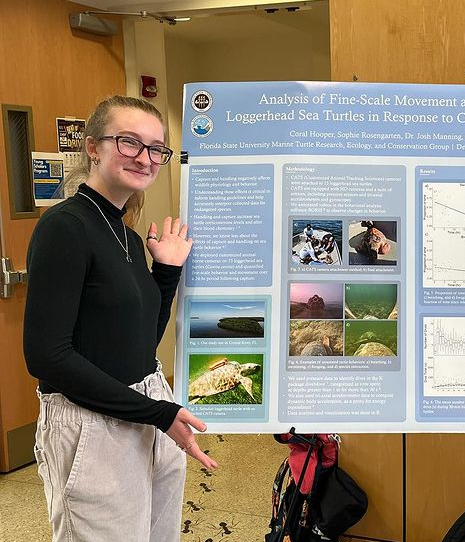
BIO
My name is Coral Hooper, and I am a third year undergraduate student working with Dr. Mariana Fuentes, Dr. Joshua Manning, and Sophie Rosengarten on researching the effects of capture and handling stress on sea turtles. I am on a pre-veterinary track, and I have a passion for helping and learning all I can about animals.
Capture and Handling Causes Short-Term Effects on the Movement and Behavior of Loggerhead Sea Turtles (Caretta caretta)
Authors: Coral Hooper, Dr. Mariana FuentesStudent Major: Biological Sciences
Mentor: Dr. Mariana Fuentes
Mentor's Department: EOAS Mentor's College: Arts and Sciences Co-Presenters: Sophie Rosengarten
Abstract
Wildlife capture and handling is often necessary to achieve research goals but can negatively affect animal physiology and behavior. Understanding the implications of these effects for endangered species is critical to inform handling protocols and for accurate data interpretation. Sea turtles are charismatic, threatened species . As such, sea turtle research is conducted globally to collect biological and ecological data. Sea turtles do not lend themselves well to observational work, often requiring capture and handling. Capture and handling are known to increase corticosterone levels and cause changes in sea turtle blood chemistry. In contrast, we know relatively little about how they affect sea turtle behavior post-release. To address this question, we deployed specialized CATS (Customized Animal Tracking Solutions) cameras on 15 loggerhead sea turtles (Caretta caretta) to investigate fine-scale movement and behavior 24-hrs post-release. Our CATS cameras record HD video of sea turtle behavior and contain several sensors that allow for analysis of fine-scale movement and diving. We annotated videos from each deployment to quantify behavior (e.g., swimming, foraging, resting) in the behavioral analysis software BORIS, and analyzed changes in these behaviors in R. These analyses were paired with analyses of movement and dive data to better understand the short-term effects of capture and handling on sea turtles. Our preliminary data suggest that turtles swim more often, dive more frequently and for longer, and rest/forage less often immediately following release, resulting in increased energy expenditure. These effects diminished quickly, and our findings suggested normal behavior resumed after approximately 160 minutes.
Keywords: Sea turtle, handling stress, Caretta caretta
24th annual Undergraduate Research Symposium, April 3, 2024
Samuel Miller Poster Session 2: 10:45 am - 11:45 am/296
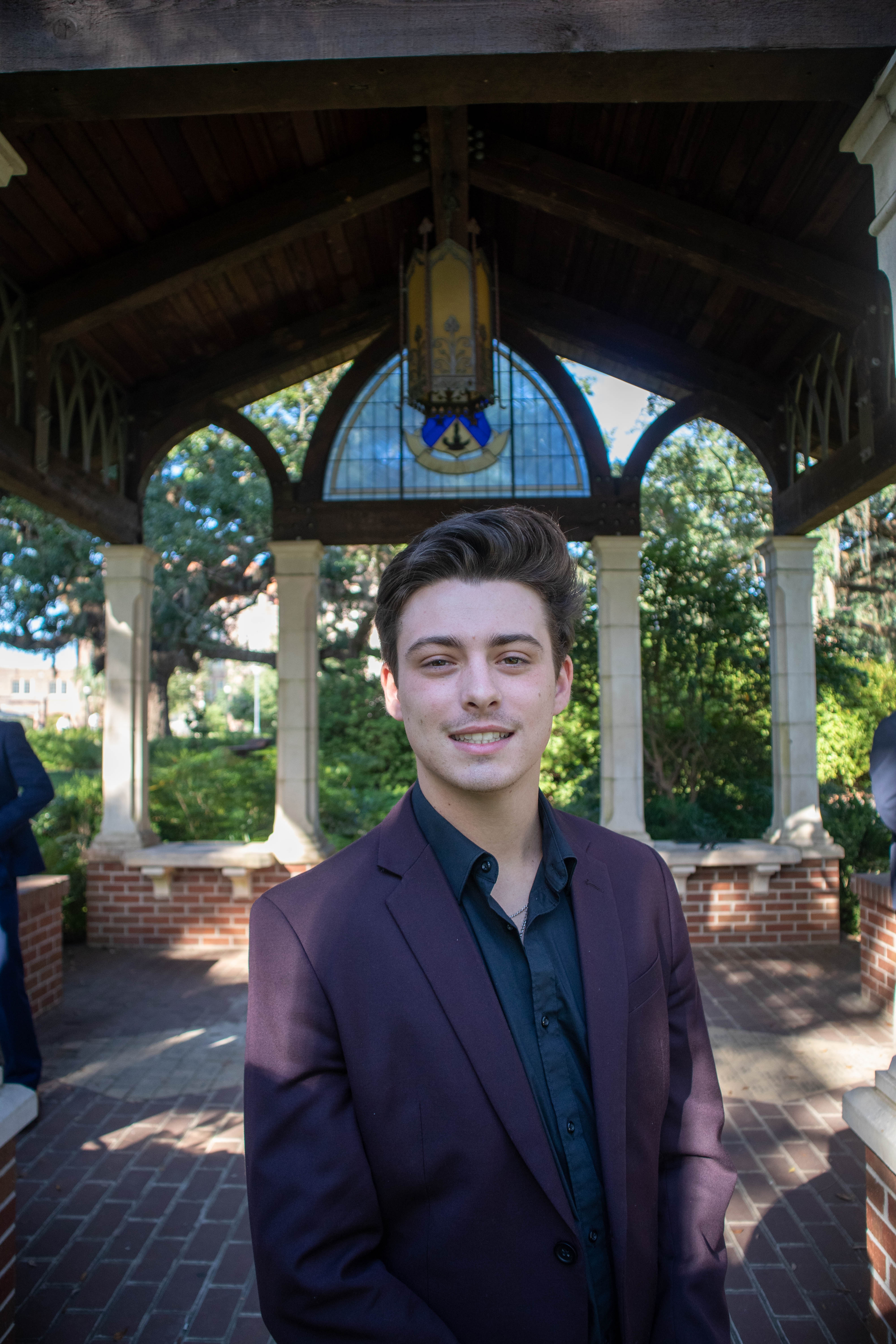
BIO
Hello! I am from Sarasota Florida and have doing research in the Hughes lab for roughly a year now. I graduate this semester, and am looking forward to what is in store!
Genetic correlations associated with body coloration, aggression, and activity levels in Drosophila melanogaster
Authors: Samuel Miller, Sarah RuckmanStudent Major: Biology
Mentor: Sarah Ruckman
Mentor's Department: Biological Science Mentor's College: College of Arts and Sciences Co-Presenters: Paulina Montes-Mendez
Abstract
One long standing question in evolutionary biology is whether single genes that control multiple traits (pleiotropy) results in limitations on adaptive evolution. If it does, then our ability to predict adaptation (e.g., in the face of changing environments) is compromised. We are using a much-discussed correlation between body coloration and aggressive behavior as a system to address this question. Having found the predicted genetic correlation between cuticle color and aggressive behavior in Drosophila melanogaster using artificial selection (unpublished data), we then asked if any other behaviors co-evolved under selection on cuticle color. For example, the dopamine synthesis pathway is plausibly related to color, aggression, and other behaviors, such as activity level. We therefore measured activity level of flies (D. melanogaster) selected for darker and lighter cuticle color. Results suggest that activity level is higher in the dark-selected lines, suggesting that genetic correlations do constrain the independent evolution of cuticle color and behavior. The next step in this study to identify candidate genes underlying the correlation and test for pleiotropic effects using transgenic approaches.
Keywords: Genetic correlations in Drosophila Melanogaster
24th annual Undergraduate Research Symposium, April 3, 2024
Lazaro Castano Poster Session 5: 4:00 pm - 5:00 pm/251

BIO
I'm a 2nd year biomedical engineering student from Naples, Florida. Throughout my life, I've wanted to make a difference, so through the combination of engineering and biology, I hope to do just that.
Structural Characterization Of Lupus Antigen-Related Proteins With Solution-State NMR & Electron Microscopy
Authors: Lazaro Castano, Nolan BlackfordStudent Major: Biomedical Engineering
Mentor: Nolan Blackford
Mentor's Department: Biochemistry Mentor's College: Biochemistry Co-Presenters:
Abstract
Type I collagen is the most abundant protein in vertebrates, but it’s rate of synthesis is slow, due to the protein’s long half-life (50-70 days) [1]. However, this rate is increased by several hundred-fold during reparative or reactive fibrosis. The mechanisms responsible for this regulation are complex, but posttranscriptional regulation plays a major role. Post transcriptional regulation is comprised of a series of steps: mRNA transport, stabilization, and translation, which are executed by mRNA binding proteins. While there are over 800 RNA binding proteins only one, La ribonucleoprotein number 6 (LARP6) is involved in type I collaged regulation [2]. It is known that LARP6 binds to the 5’ stem loop in sequence manner, recruiting other proteins, including: non-muscle myosin, vimentin, RNA helicase A, serine threonine kinase receptor associated protein, and 25 kD FK506 binding protein, which increase the stability and translatability of type I collagen mRNAs [3]. It is also known that high levels of LARP6 contribute to fibrotic disease [4]. However, little is known about LARP6’s 3-demensional structure and domain-orientation due to its size, which makes it too large for nuclear magnetic resonance spectroscopy (NMR), yet too small for electron microscopy (EM). Furthermore, the unbonded protein’s instability at high concentrations further exacts collecting NMR data. Here, we will utilize a tRNA scaffold to enable structural characterization of LARP6 via Cryo-EM. Furthermore, we will reexamine the protein using NMR spectroscopy attempting previously failed techniques.
Keywords: LARP6, NMR, Protein Structural Characterization
24th annual Undergraduate Research Symposium, April 3, 2024
Renee Weissberger Poster Session 2: 10:45 am - 11:45 am/164

BIO
I am Renee Weissberger, a senior at Florida State University majoring in Biological Sciences. I am currently earning a bachelor's degree with hopes to pursue a doctorate in Optometry. Currently, I am engaged in research at the Lazenby lab focusing on electrochemistry. Through this work, I have developed an interest and comprehension of electrolysis, an electrochemical water splitting technique.
The role of Fe incorporation in the oxygen evolution reaction electrocatalysts
Authors: Renee Weissberger, Robert LazenbyStudent Major: Biological Science
Mentor: Robert Lazenby
Mentor's Department: Electrochemistry Mentor's College: Florida State University Co-Presenters:
Abstract
Conventional methods for hydrogen production emit significant amounts of greenhouse gases. To mitigate the environmental impact, we can utilize electrochemical water-splitting as a cleaner alternative for producing hydrogen. This method involves two half reactions: the hydrogen evolution reaction (HER) and the oxygen evolution reaction (OER). OER is often recognized for its sluggish kinetics but introducing an efficient catalyst can enhance the rate of oxygen production and improve the efficiency of the overall reaction. The electrocatalytic performance and durability of transition metal (TM) non-oxide-based catalysts for OER have recently been reported. However, there remains a significant knowledge gap in identifying long-term effects of electrochemical surface oxidation on these materials. Here, we show that the intentional incorporation of Fe to other transition metal based (Co, Ni, Cr) carbides can enhance the initial OER activity, but as Fe surface oxides form the OER activity can degrade. To understand the complex effects of Fe in non-oxide-based catalysts, the long-term electrochemical stability of mono- and multi-metallic carbide catalysts were investigated. In this work, Fe-purified KOH and KOH containing trace amounts of Fe were used to compare the electrochemical stability performance of the carbides using voltametric techniques. These measurements enabled the evaluation of the catalytic activity and stability for non-oxide-based catalysts and demonstrated the impact Fe has on initial OER activity enhancement and long-term activity over time. Our study for the role of Fe aims to inform the design of future non-oxide electrocatalysts for the OER, advancing sustainable and affordable hydrogen production and storage.
Keywords: Electrocatalysis, Electrolysis, Catalysts, Carbides




